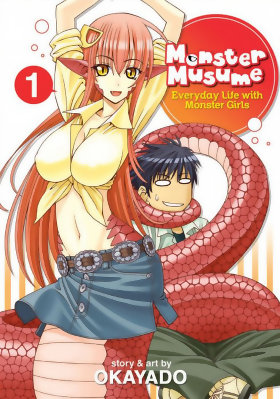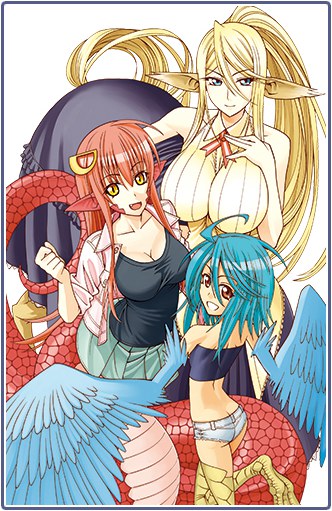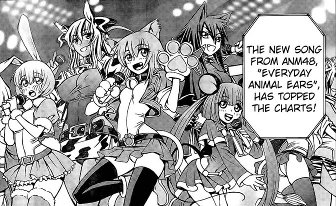Review: 'Monster Musume', vol. 1, by OKAYADO
 Oops. This manga would be a lot funnier if not for the serious news in August of a man in Idaho being arrested for having sex with a cat. Many of Flayrah’s readers wondered how that was possible, considering the size differences of a human’s and a cat’s sex apparatus.
Oops. This manga would be a lot funnier if not for the serious news in August of a man in Idaho being arrested for having sex with a cat. Many of Flayrah’s readers wondered how that was possible, considering the size differences of a human’s and a cat’s sex apparatus.
One of the ongoing questions in Monster Musume is how Kurusu, the terrified human teenaged protagonist, is going to have sex with a snake? Well, Miia’s human above the waist. And with boobs that, like the Maryland judge said describing Jane Russell’s (in banning the movie The Outlaw), "breasts hung like a thunderstorm over a summer landscape." And Miia really, really, REALLY wants to f--- with him, despite his genteel inhibitions.
So does Papi, the harpy. Well, when she’s old enough. She’s about the equivalent of a nine- or ten-year-old human girl. And, being a bird-girl, noticeably feather-brained, too. (Kurusu isn’t into cradle-robbing, either.)
And Centorea, the centauress. No “centaurette” as in Disney’s Fantasia; this is a dignified but horny adolescent female centaur. The centaurs are supposed to be too haughty to comingle with humans, but Centorea proves the old adage that you can justify anything if you try hard enough.
Los Angeles, CA, Seven Seas Entertainment, October 2013, trade paperback $12.99 (unpaged [192 pages]). Translated by Ryan Peterson.
“Three years ago”, the mythological half-animals of fantasy returned to Earth and turned out to be real. “The government” has established the Cultural Exchange Between Species Act, and is trying to integrate them into human society. Kurusu Kimihito, an easily-led handsome human teenager, is persuaded to sign up for the government’s exchange program and welcome a half-animal “friendly monster” as his housemate. Kurusu doesn’t expect that the half-animal will turn out to be Miia, a big-boobed boy-crazy lamia who expects him to pop her cherry.
 Kurusu has enough trouble trying to keep her from sharing his showers without Coordinator Smith, his leering female government exchange representative (who is obviously jealous because Miia has bigger boobs than she does), constantly reminding him that the laws against interspecies breeding are very strict, and that giving in to temptation means deportation for Miia and prison for the rest of his life. The human volunteers are only supposed to have a single monster exchange student, but Smith-san keeps finding loopholes to saddle Kurusu with all of her most troublesome monster clients.
Kurusu has enough trouble trying to keep her from sharing his showers without Coordinator Smith, his leering female government exchange representative (who is obviously jealous because Miia has bigger boobs than she does), constantly reminding him that the laws against interspecies breeding are very strict, and that giving in to temptation means deportation for Miia and prison for the rest of his life. The human volunteers are only supposed to have a single monster exchange student, but Smith-san keeps finding loopholes to saddle Kurusu with all of her most troublesome monster clients.
The first five-plus chapters of Monster Musume do not fill this volume by themselves. There is a preview of A Centaur’s Life by Kei Murayama, published by Seven Seas in November.
Himeno is a sweet, shy girl, who like many teens her age, struggles with the trials and tribulations of attending high school. The difference is she's a centaur; but she's not alone. In fact, all of her classmates are supernatural creatures, sporting either horns, wings, tails, halos, or some other unearthly body appendage. Yet despite their fantastical natures, Himeno and her best friends-the dragon-winged Nozomi, and Kyoko with her spiraled horns-are down-to-earth, fun-loving teenagers who grapple with issues of life and love in a mostly normal daily school setting.
Monster Musume is in the subcategory of what anime fans call the “harem fantasy”. That is a Japanese TV animated series about an easily-embarrassed adolescent high-school boy who finds himself surrounded by sexy young teachers, boy-crazy coeds, and one or more young female ghosts or jinnis or outer-space girls, all fighting over which will get to marry him. That’s for TV animation, which is toned down for public broadcast. Monster Musume is a comic book for horny teenage boys, which does not have to be so circumspect. The monster girls are all sex-crazy and just want to have uninhibited sex with Kurusu; never mind marriage. In public; they don’t mind. As the back-cover blurb says, “what's a full-blooded teenage human with raging hormones to do?!”
What makes Monster Musume pertinent to Flayrah is that the girls are all part-animal girls, which in Japan means cat-girls, rabbit-girls, and in this volume, a lamia (snake-girl), a harpy (bird-girl), and a centauress (horse-girl). It’s not quite the type of anthropomorphization that Flayrah is used to, but so what? Prepare to expand your horizons. Future volumes will introduce a shape-shifter, a mermaid, a spider-girl, a succubus, and more. (Flayrah’s readers who are not into girls can skip this one.)
While this type of comic book is not unusual in Japan, publication of an American edition is. It is age-rated for “Older Teens”, and is probably NSFW considering all of the closeups of animal-girls flaunting their jiggly boobs. Seven Seas Entertainment has done an excellent adaptation. The English-language dialogue is just about the only clue that this is not a Japanese tank?bon; the paperback collections of serialized comic-book magazine episodes.
I am in awe of Ryan Peterson’s superb translation. He makes Papi’s Japanese baby-talk seem like normal English without losing its babyish aspect, and Centorea’s aristocratic English flow smoothly without seeming overly archaic. The dialogue is full of puns – bird-related for Papi and horse-related for Centorea – and Peterson fields them all. “I’m so jealous I could just moult!!” “You shouldn’t have a cockfight out here for everyone to gawk at!” “Wow…I can’t believe you winged it like that.” “A-all right! You’re really champing at the bit!” “Well, what now? You can’t expect me to hoof it!” “I bridle at your pathetic attempts! Is that all thou hast?!”
 Monster Musume no Iru Nichijo (“Everyday Life With Monster Girls”) began serialization in Monthly Comic Ry? on March 19, 2012, and has only had three tank?bon collections so far, so Seven Seas is practically grabbing this hot off the press. Volume 2 of the American edition will be published in January 2014, and volume 3 in May.
Monster Musume no Iru Nichijo (“Everyday Life With Monster Girls”) began serialization in Monthly Comic Ry? on March 19, 2012, and has only had three tank?bon collections so far, so Seven Seas is practically grabbing this hot off the press. Volume 2 of the American edition will be published in January 2014, and volume 3 in May.
Tokuma Shoten (Tokuma Publishing Co.), the Tokyo-based publisher of both Monthly Comic Ry? magazine and the tankobon reprint collections of the comic-book serials in it, has also been subsididing anime production since the 1970s, including Hayao Miyazaki’s 1983 Nausicaä of the Valley of the Wind. It was Tokuma Publishing that set up and financed Miyazaki’s and Isao Takahata’s Studio Ghibli until the studio was able to support itself. (Personal note: I briefly met Yasuyoshi Tokuma, the company’s founder, in 1983. He made no bones about believing that the Imperial Japanese government should have won World War II, and he was delighted that Americans were finally succumbing to Japanese animation and comics. Whatever works.)
About the author
Fred Patten — read stories — contact (login required)a retired former librarian from North Hollywood, California, interested in general anthropomorphics
Comments
Post new comment